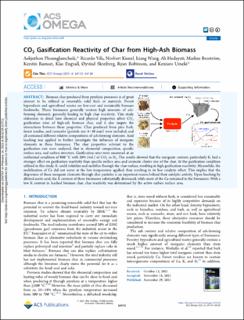| dc.description.abstract | Biomass char produced from pyrolysis processes is of great interest to be utilized as renewable solid fuels or materials. Forest byproducts and agricultural wastes are low-cost and sustainable biomass feedstocks. These biomasses generally contain high amounts of ash-forming elements, generally leading to high char reactivity. This study elaborates in detail how chemical and physical properties affect CO2 gasification rates of high-ash biomass char, and it also targets the interactions between these properties. Char produced from pine bark, forest residue, and corncobs (particle size 4–30 mm) were included, and all contained different relative compositions of ash-forming elements. Acid leaching was applied to further investigate the influence of inorganic elements in these biomasses. The char properties relevant to the gasification rate were analyzed, that is, elemental composition, specific surface area, and carbon structure. Gasification rates were measured at an isothermal condition of 800 °C with 20% (vol.) of CO2 in N2. The results showed that the inorganic content, particularly K, had a stronger effect on gasification reactivity than specific surface area and aromatic cluster size of the char. At the gasification condition utilized in this study, K could volatilize and mobilize through the char surface, resulting in high gasification reactivity. Meanwhile, the mobilization of Ca did not occur at the low temperature applied, thus resulting in its low catalytic effect. This implies that the dispersion of these inorganic elements through char particles is an important reason behind their catalytic activity. Upon leaching by diluted acetic acid, the K content of these biomasses substantially decreased, while most of the Ca remained in the biomasses. With a low K content in leached biomass char, char reactivity was determined by the active carbon surface area. | en_US |

